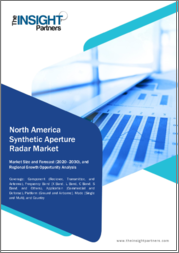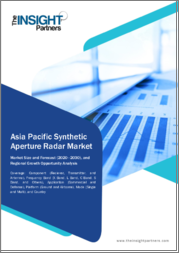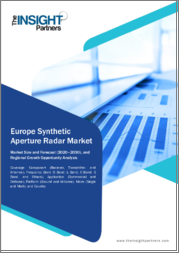
|
시장보고서
상품코드
1570922
합성 개구 레이더(SAR) 시장, 기회, 성장 촉진요인, 산업 동향 분석과 예측(2024-2032년)Synthetic Aperture Radar (SAR) Market, Opportunity, Growth Drivers, Industry Trend Analysis and Forecast, 2024-2032 |
||||||
세계의 합성 개구 레이더(SAR) 시장은 2023년에 265억 3,400만 달러로 평가되며, 2024-2032년 CAGR 10% 이상으로 성장할 것으로 예측됩니다.
지구관측은 SAR 시장 성장의 주요 촉진요인이며, SAR 기술은 날씨와 조명 조건에 구애받지 않고 작동하므로 환경 및 지역적 조건을 모니터링하는 데 매우 효과적입니다. 광학 센서와 달리 SAR은 구름, 안개, 어둠 속에서도 고해상도 이미지를 포착할 수 있으며, 기후 모니터링, 재난 대응, 농업 관리 등에 매우 유용합니다. 유럽우주국(ESA)은 아마존 삼림 벌채와 극지방의 빙하 감소를 추적하는 데 있으며, SAR의 중요성을 강조하고 있습니다. 정부, 연구기관, 기업은 토지 이용 모니터링, 재난 영향 평가, 자원 관리에 SAR을 활용하고 있습니다. 다양한 분야에서 정밀한 지구관측 데이터에 대한 수요가 증가하면서 SAR 시장이 발전하고 있습니다.
시장은 용도별로 우주선, 항공기, 무인항공기(UAV)로 구분되며, 우주선 부문은 2032년까지 374억 달러를 넘어설 것으로 예상됩니다. 우주선 부문은 우주에서 고해상도 지구관측에 대한 수요가 주도하고 있으며, SAR을 탑재한 위성은 환경 감시, 재난 대응 및 방어를 위한 탁월한 이미징을 제공합니다. 레이더 해상도 향상과 데이터 처리 속도 향상 등 기술 발전으로 우주에서 SAR의 용도가 확대되고 있습니다. 위성 임무 증가와 차세대 SAR 위성이 이 부문의 성장을 가속하고 있습니다.
시장은 최종 용도별로 연구 및 상업용과 국방용으로 구분되며, 전자는 2024-2032년 연평균 10% 이상의 CAGR을 기록하며 급성장하는 분야로 부상하고 있습니다. 연구 및 상업용 용도 부문은 다양한 분야에서 고해상도 이미지에 중점을 두고 있으며, SAR 기술은 환경 연구, 농업 및 재난 모니터링에서 과학적 분석과 정보에 입각한 의사결정을 촉진하는 데 매우 중요한 역할을 합니다. 상업적으로 SAR 시스템은 인프라, 도시 계획 및 자원 관리에 필수적이며, 정밀하고 신뢰할 수 있는 이미지를 제공하며, 2023년 Synspective의 StriX-B 위성 발사는 SAR 시스템의 다목적성과 응용 범위의 확장을 강조합니다.
2023년 북미가 세계 SAR 시장을 주도하여 38% 이상의 점유율을 차지할 것입니다. 미국이 선두에 서서 레이더 기술과 국방에서 큰 진전을 이루면서 SAR은 감시와 정찰에서 중요한 역할을 하고 있습니다. 국방뿐만 아니라 SAR은 환경 감시와 자원 관리에도 적용되고 있습니다. 미국 해양대기청(NOAA)은 자연재해 감시와 자원 관리에서 SAR의 중요성을 강조하고 있습니다. 정부의 강력한 지원과 유리한 방위 계약과 함께 이 지역은 특히 차세대 SAR 위성 및 시스템의 발전을 목격하고 있습니다.
목차
제1장 조사 방법과 조사 범위
제2장 개요
제3장 업계 인사이트
- 에코시스템 분석
- 벤더 매트릭스
- 이익률 분석
- 테크놀러지와 혁신 전망
- 특허 분석
- 주요 뉴스와 구상
- 규제 상황
- 영향요인
- 촉진요인
- 지구 관측에 대한 수요 증가
- 군·방위 분야에서 SAR 이용의 증가
- SAR 기술의 상업 이용 증가
- 투자와 정부 구상
- SAR 기술의 진보
- 업계의 잠재적 리스크 & 과제
- 합성 개구 레이더의 높은 개발비
- 복잡한 데이터 처리
- 촉진요인
- 성장 가능성 분석
- Porter의 산업 분석
- PESTEL 분석
제4장 경쟁 구도
- 서론
- 기업 점유율 분석
- 경쟁 포지셔닝 매트릭스
- 전략 전망 매트릭스
제5장 시장 추산·예측 : 주파수대별, 2021-2032년
- 주요 동향
- 단일 주파수대
- X밴드
- C밴드
- S밴드
- L밴드
- K/Ku/Ka밴드
- 멀티 주파수대역
제6장 시장 추산·예측 : 컴포넌트별, 2021-2032년
- 주요 동향
- 수신기
- 송신기
- 안테나
제7장 용도별 시장 추산·예측 : 용도별, 2021-2032년
- 주요 동향
- 연구 및 상업 용도
- 공공안전
- 환경 모니터링
- 천연자원 탐사
- 기타
- 방위
제8장 시장 추산·예측 : 플랫폼별, 2021-2032년
- 주요 동향
- 항공기
- 지상형
- 스페이스본
제9장 시장 추산·예측 : 용도별, 2021-2032년
- 주요 동향
- 우주선
- 항공기
- UAV(무인항공기)
제10장 시장 추산·예측 : 지역별, 2021-2032년
- 주요 동향
- 북미
- 미국
- 캐나다
- 유럽
- 영국
- 독일
- 프랑스
- 이탈리아
- 스페인
- 기타 유럽
- 아시아태평양
- 중국
- 인도
- 일본
- 한국
- 뉴질랜드
- 기타 아시아태평양
- 라틴아메리카
- 브라질
- 멕시코
- 기타 라틴아메리카
- 중동 및 아프리카
- UAE
- 남아프리카공화국
- 사우디아라비아
- 기타 중동 및 아프리카
제11장 기업 개요
- Airbus
- Capella Space
- Harris Corporation
- ICEYE
- Israel IAI
- OHB System AG
- MDA Corp.(Maxar Technologies)
- Northrop Grumman
- Raytheon
- Thales
- UrtheCast Corp
- BAE Systems
- Lockheed Martin
- Terrasigna SRL
- SkyGeo
- TRE Altamira
- CGG
- Umbra Lab
- GroundProbe
- Saab AB
- Leonardo S.P.A.
- Aselsan
- Cobham PLC
- General Atomics Aeronautical Systems, Inc.
The Global Synthetic Aperture Radar (SAR) Market was valued at USD 26,534.0 million in 2023 and is projected to grow at a CAGR of over 10% from 2024 to 2032. Earth observation is a key driver of the SAR market's growth. SAR technology is highly effective in monitoring environmental and geographical conditions, as it operates independently of weather and lighting conditions. Unlike optical sensors, SAR can capture high-resolution images through clouds, fog, and darkness, making it invaluable for climate monitoring, disaster response, and agricultural management. The European Space Agency (ESA) emphasizes SAR's importance in tracking deforestation in the Amazon and polar ice loss. Governments, research institutions, and businesses rely on SAR for land use monitoring, disaster impact assessments, and resource management. The growing demand for precise Earth observation data across various sectors is propelling the SAR market forward.
The overall Synthetic Aperture Radar (SAR) industry is classified based on the frequency band, component, application, end-user, and region.
The market is segmented by application into spacecraft, aircraft, and UAVs, with the spacecraft segment projected to exceed USD 37,400 million by 2032. The spacecraft segment is driven by the demand for high-resolution Earth observation from space. Satellites equipped with SAR provide unparalleled imaging for environmental monitoring, disaster response, and defense. Technological advancements, like enhanced radar resolution and faster data processing, expand SAR's applications in space. The increasing number of satellite missions and next-generation SAR satellites bolster this segment's growth.
Divided by end-use, the market segments into research and commercial applications and defense, with the former emerging as the fastest-growing segment, boasting a CAGR of over 10% from 2024 to 2032. The research and commercial applications segment emphasizes high-resolution imagery across various sectors. SAR technology is pivotal in environmental studies, agriculture, and disaster monitoring, facilitating scientific analysis and informed decisions. Commercially, SAR systems are vital in infrastructure, urban planning, and resource management, providing intricate and reliable imaging. Synspective's 2023 launch of the StriX-B satellite underscores the growing versatility and expansive application range of SAR systems.
In 2023, North America led the global SAR market, capturing over 38% of the share. The U.S. stands at the forefront, making significant strides in radar technology and defense, with SAR playing a crucial role in surveillance and reconnaissance. Beyond defense, SAR's applications in environmental monitoring and resource management are gaining traction. The National Oceanic and Atmospheric Administration (NOAA) emphasizes SAR's importance in natural disaster monitoring and resource management. Coupled with strong government backing and lucrative defense contracts, the region is witnessing advancements, especially in next-generation SAR satellites and systems.
Table of Contents
Chapter 1 Methodology and Scope
- 1.1 Market scope and definition
- 1.2 Base estimates and calculations
- 1.3 Forecast calculation
- 1.4 Data sources
- 1.4.1 Primary
- 1.4.2 Secondary
- 1.4.2.1 Paid sources
- 1.4.2.2 Public sources
Chapter 2 Executive Summary
- 2.1 Industry 360º synopsis, 2021 - 2032
Chapter 3 Industry Insights
- 3.1 Industry ecosystem analysis
- 3.2 Vendor matrix
- 3.3 Profit margin analysis
- 3.4 Technology and innovation landscape
- 3.5 Patent analysis
- 3.6 Key news and initiatives
- 3.7 Regulatory landscape
- 3.8 Impact forces
- 3.8.1 Growth drivers
- 3.8.1.1 The growing demand for earth observation
- 3.8.1.2 Increasing use of SAR in military and defense
- 3.8.1.3 Increasing commercial application of SAR technology
- 3.8.1.4 Investments and government initiatives
- 3.8.1.5 Growing advancements in SAR technology
- 3.8.2 Industry pitfalls and challenges
- 3.8.2.1 High development cost for synthetic aperture radar
- 3.8.2.2 Complex Data Processing
- 3.8.1 Growth drivers
- 3.9 Growth potential analysis
- 3.10 Porter's analysis
- 3.10.1 Supplier power
- 3.10.2 Buyer power
- 3.10.3 Threat of new entrants
- 3.10.4 Threat of substitutes
- 3.10.5 Industry rivalry
- 3.11 PESTEL analysis
Chapter 4 Competitive Landscape, 2023
- 4.1 Introduction
- 4.2 Company market share analysis
- 4.3 Competitive positioning matrix
- 4.4 Strategic outlook matrix
Chapter 5 Market Estimates and Forecast, By Frequency Band, 2021 - 2032 (USD million)
- 5.1 Key trends
- 5.2 Single frequency band
- 5.2.1 X band
- 5.2.2 C band
- 5.2.3 S band
- 5.2.4 L band
- 5.2.5 K/Ku/Ka band
- 5.3 Multi-frequency band
Chapter 6 Market Estimates and Forecast, By Component, 2021 - 2032 (USD million)
- 6.1 Key trends
- 6.2 Receiver
- 6.3 Transmitter
- 6.4 Antenna
Chapter 7 Market Estimates and Forecast, By End-Use, 2021 - 2032 (USD million)
- 7.1 Key trends
- 7.2 Research and Commercial Applications
- 7.2.1 Public Safety
- 7.2.2 Environmental Monitoring
- 7.2.3 Natural Resource Exploration
- 7.2.4 Others
- 7.3 Defense
Chapter 8 Market Estimates and Forecast, By Platform, 2021 - 2032 (USD million)
- 8.1 Key Trends
- 8.2 Airborne
- 8.3 Ground-Based
- 8.4 Spaceborne
Chapter 9 Market Estimates and Forecast, By Application, 2021 - 2032 (USD million)
- 9.1 Key trends
- 9.2 Spacecraft
- 9.3 Aircraft
- 9.4 UAV
Chapter 10 Market Estimates and Forecast, By Region, 2021 - 2032 (USD million)
- 10.1 Key trends
- 10.2 North America
- 10.2.1 U.S.
- 10.2.2 Canada
- 10.3 Europe
- 10.3.1 UK
- 10.3.2 Germany
- 10.3.3 France
- 10.3.4 Italy
- 10.3.5 Spain
- 10.3.6 Rest of Europe
- 10.4 Asia Pacific
- 10.4.1 China
- 10.4.2 India
- 10.4.3 Japan
- 10.4.4 South Korea
- 10.4.5 ANZ
- 10.4.6 Rest of Asia Pacific
- 10.5 Latin America
- 10.5.1 Brazil
- 10.5.2 Mexico
- 10.5.3 Rest of Latin America
- 10.6 MEA
- 10.6.1 UAE
- 10.6.2 South Africa
- 10.6.3 Saudi Arabia
- 10.6.4 Rest of MEA
Chapter 11 Company Profiles
- 11.1 Airbus
- 11.2 Capella Space
- 11.3 Harris Corporation
- 11.4 ICEYE
- 11.5 Israel IAI
- 11.6 OHB System AG
- 11.7 MDA Corp. (Maxar Technologies)
- 11.8 Northrop Grumman
- 11.9 Raytheon
- 11.10 Thales
- 11.11 UrtheCast Corp
- 11.12 BAE Systems
- 11.13 Lockheed Martin
- 11.14 Terrasigna SRL
- 11.15 SkyGeo
- 11.16 TRE Altamira
- 11.17 CGG
- 11.18 Umbra Lab
- 11.19 GroundProbe
- 11.20 Saab AB
- 11.21 Leonardo S.P.A.
- 11.22 Aselsan
- 11.23 Cobham PLC
- 11.24 General Atomics Aeronautical Systems, Inc.



















